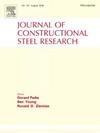热伸长受限的非承重 LSF 墙体的耐火性能
IF 4
2区 工程技术
Q1 CONSTRUCTION & BUILDING TECHNOLOGY
引用次数: 0
摘要
在这项研究中,基于适当合理的热分析和顺序耦合结构 FE(有限元)分析,深入分析了具有热伸长约束的非承重 LSF(轻型钢框架)墙体的耐火性能和 FRL(耐火等级)。有限元分析结果证实,上述墙体的 CFS(冷弯型钢)槽壁螺栓因火灾影响和螺栓端部的热伸长约束产生的额外压缩荷载而过早坍塌,导致这些墙体的耐火等级降低。此外,墙体高度和墙柱端部与刚性地板之间的间隙也对具有热伸长限制的非承重 LSF 墙体的 FRL 有显著影响。与此相反,CFS 槽壁柱和空腔保温层的厚度和深度的影响不大。最后,针对澳大利亚常用的几种非承重耐火 LSF 墙体,提出了简化可靠的设计方程和一些建议。本文介绍了这项研究的详细内容,包括其分析、结果和建议。本文章由计算机程序翻译,如有差异,请以英文原文为准。
Fire resistance behaviour of non-load bearing LSF walls with restrained thermal elongation
In this research study, based on suitable and rational thermal and sequentially coupled structural FE (finite element) analyses, the fire resistance behaviour and FRLs (fire resistance levels) of non-load bearing LSF (light gauge steel framed) walls with restrained thermal elongation were deeply analysed. The FE analysis results confirmed that CFS (cold-formed steel) channel studs of the mentioned walls collapsed prematurely due to additional compression loads caused by the effects of fire and the thermal elongation restraints at stud ends, which led to the reduced FRLs of these walls. Besides, the wall height and the clearance between the stud ends and rigid floors were shown as having significant effects on the FRLs of non-load bearing LSF walls with restrained thermal elongation. In contrast, the effects of the thickness and depth of CFS channel studs and cavity insulation were inconsiderable. Finally, a simplified and reliable design equation and some recommendations were proposed for some types of non-load bearing fire-rated LSF walls commonly used in Australia. This paper presents details of this study, including its analyses, outcomes, and proposals.
求助全文
通过发布文献求助,成功后即可免费获取论文全文。
去求助
来源期刊

Journal of Constructional Steel Research
工程技术-工程:土木
CiteScore
7.90
自引率
19.50%
发文量
550
审稿时长
46 days
期刊介绍:
The Journal of Constructional Steel Research provides an international forum for the presentation and discussion of the latest developments in structural steel research and their applications. It is aimed not only at researchers but also at those likely to be most affected by research results, i.e. designers and fabricators. Original papers of a high standard dealing with all aspects of steel research including theoretical and experimental research on elements, assemblages, connection and material properties are considered for publication.
 求助内容:
求助内容: 应助结果提醒方式:
应助结果提醒方式:


